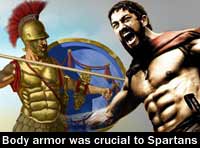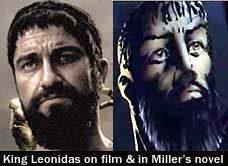300 (2007)
| REEL FACE: | REAL FACE: |
Gerard Butler
Born: November 13, 1969 Birthplace: Glasgow, Scotland, UK | King Leonidas
Born: ~540 B.C. Birthplace: Sparta, Greece Death: 480 B.C., Thermopylae, Greece (fatally wounded by arrows in the Battle of Thermopylae) |
Rodrigo Santoro
Born: August 22, 1975 Birthplace: Petrópolis, Rio de Janeiro, Brazil | Xerxes
Born: 519 B.C. Birthplace: Persia Death: 465 B.C., Persepolis, Persia (assassination by stabbing, likely by his political advisor Artabanus) |
Immortals (300 Movie)
Frank Miller's disfigured Imperial soldiers who fight behind shiny metal masks, using a martial-arts-like fighting style | Immortals (Persian History)
The Immortals were an Imperial Guard regiment that protected the Persian rulers during the time of the Greco-Persian Wars. |
Did the Spartans really fight with virtually no body armor?

Why is King Leonidas the only Spartan in the movie wearing a plumed helmet?

In what year did the Battle of Thermopylae take place?
Historians who study the 300 Spartans history are positive that the battle took place in 480 B.C. They only argue over whether it happened in August or mid-September of that year.  See what the Battle of Thermopylae site looks like today.
See what the Battle of Thermopylae site looks like today.
Were the Spartans really 'good guys'?

Did the Spartans really discard their unfit offspring?
Yes. In the movie, we see a government official holding King Leonidas' (Gerard Butler) newborn son above a cliff. The official is inspecting the newborn to decide if it should be discarded. Greek historian Plutarch (46 A.D. - 127 A.D.) spoke of the Spartan practice of eugenics in his writings:
"If after examination the baby proved well-built and sturdy they [the state] instructed the father to bring it up, and assigned it one of the 9,000 lots of land. But if it was puny and deformed, they dispatched it to what was called 'the place of rejection', a precipitous spot by Mount Taygetus, considering it better both for itself and the state that the child should die if right from its birth it was poorly endowed for health or strength."
Plutarch also wrote about various other customs that the Spartans used to ensure their "good stock":
"If an older man with a young wife should take a liking to one of the well-bred young men and approve of him, he might well introduce him to her so as to fill her with noble sperm and then adopt the child as his own. Conversely, a respectable man who admired someone else's wife noted for her lovely children and her good sense, might gain the husband's permission to sleep with her -- thereby planting in fruitful soil, so to speak, and producing fine children who would be linked to fine ancestors by blood and family."
 300 - Frank Miller's Graphic Novel
300 - Frank Miller's Graphic NovelIf you enjoyed the artistic style of the movie (shot almost entirely against green screens), Frank Miller's graphic novel on which the movie is based is a must have. With impressive art and writing, the graphic novel's story is limited only by one's imagination.
Did Spartan boys really leave home at the age of 7 for warrior training?
Yes. As shown in the film, on a young Spartan male's seventh birthday, he would leave home to begin an education and training regime known as the agoge. In addition to separation from one's family, the agoge involved cultivation of loyalty to one's group, loving mentorship, military training, hunting, dance and social preparation. The literal translation of agoge is 'raising'. The boys lived in groups (agelae, herds) under an older boy leader. They put their loyalty to their group above their family. Even after they were married, they would not eat dinner with their wives until they were 25 (formal agoge training ended at age 18). Sons of the King were the only males exempt from the agoge.
Was Leonidas' right of passage really to kill a wolf in the woods?
No. A Spartan boy's right of passage was not to kill a wolf, it was to sneak out and murder a slave (Helot). If you were discovered, then you would be punished severely, not for taking the life of another human being, but rather for getting caught. Murdering a slave was meant to train you in the art of evasion.Did Sparta go up against the Persians alone?
No. Perhaps the biggest problem with the movie 300 is that the film leaves the audience believing that the Spartans were the only Greek force to lead an attack against the Persians. The movie leaves out the decisive amphibious battle that took place in the straits adjacent to Thermopylae, where allied Greek fleets led by Athens held off the Persian fleets. Soon after, this Athenian led fleet saved Greece by destroying the Persian fleet during the Battle of Salamis, which marked the turning point in the war. Sparta and Athens working together also marked the beginning of Greece as a unified nation, instead of a collection of warring city-states. Prior to these battles, it was originally the Athenians who had asked Leonidas to help them defend against the Persians.
Was the Persian King Xerxes really bald and 9-feet-tall?
No. The real Persian King Xerxes had a beard and was much shorter. He never went to the front line at the Battle of Thermopylae as his character does in the movie 300. Actor Rodrigo Santoro portrays the 9-foot-tall Xerxes in the film. Rodrigo, who starred on ABC's Lost, is around 6'2". His height and voice were both altered for the role of the Persian King. Director Zack Snyder talked about Xerxes' exaggerated features in an interview, "...because we scaled him as we did, when his normal voice played, it was even stranger to me. He was out of scale of his voice, not that it wasn't commanding." The actor's actual voice is heard in the film, only with the pitch scaled down.
Did Leonidas really consult an Oracle to aid in his decision to go to battle?

Did the Persians really use charging elephants and rhinos at Thermopylae?
No. The Persians didn't bring any charging elephants or rhinos to the Battle of Thermopylae. This was a liberty taken by 300 author Frank Miller and the filmmakers, in order to add to the movie's elements of fantasy. The Persians did use horses in battle, as their army was twenty percent cavalry.
Is the movie's hunchbacked traitor Ephialtes based on a real person?

Are the Immortals based on a real Persian fighting unit?
Yes. The Immortals were Xerxes personal bodyguards.  See an ancient rendering of the Immortals. They were an elite fighting unit. In the film, they wear shiny masks to hide their horrific faces, which is an element of fiction created by 300 author Frank Miller. In reality, the Immortals wrapped their faces in cloth that they could see through. The downfall of the Immortals was that they were lightly armored when compared to the Greek hoplites. Their shields were only made of wicker and were no match for the Spartan weapons. They were called the Immortals because they always maintained a strength of exactly 10,000 men. Whenever an Immortal was killed or wounded, he was immediately replaced by a new one; thus maintaining the cohesion of the unit.
See an ancient rendering of the Immortals. They were an elite fighting unit. In the film, they wear shiny masks to hide their horrific faces, which is an element of fiction created by 300 author Frank Miller. In reality, the Immortals wrapped their faces in cloth that they could see through. The downfall of the Immortals was that they were lightly armored when compared to the Greek hoplites. Their shields were only made of wicker and were no match for the Spartan weapons. They were called the Immortals because they always maintained a strength of exactly 10,000 men. Whenever an Immortal was killed or wounded, he was immediately replaced by a new one; thus maintaining the cohesion of the unit.
Does 300 accurately represent Spartan women?
Yes. The movie presents a strong willed Queen Gorgo (Lena Headey), who advises her husband on both military and political matters. At one point in the film, a Persian messenger insults the Queen after she offers her input during a political discussion. The Persian felt that the Queen (a woman) should not speak on such matters. The film's depiction of the role of Spartan women is accurate. The relative freedom and empowerment of their women helped to further set the Spartans apart from other cultures. The empowerment of Spartan women could be compared to the freedoms of modern day American women versus the restricted roles of many present day Middle Eastern women.
Did Queen Gorgo really kill council member Theron?
No. This is an element of fiction added by the filmmakers to enhance the role of the Queen in the storyline. In an Entertainment Weekly interview, author of 300 Frank Miller stated his opposition to this alteration of his graphic novel, "At first I very much disagreed with it. My main comment was, 'This is a boys' movie. Let it be that.' The story itself, in historical terms, really didn't involve her all that much, from most accounts. But Zack had his reasons. He wanted to show that King Leonidas was fighting for something, by giving him a romantic aspect and by lingering in Sparta a little bit." In reality, Queen Gorgo's husband King Leonidas was her half uncle. Leonidas and Gorgo's father Cleomenes were paternal half-brothers.
Did Queen Gorgo really have an active role in the Spartan political arena?
Yes. Greek historian Herodotus mentions her several times in his writings. When she was only eight or nine-years old, she advises her father to not trust Aristagoras: "Father, you had better go away, or the stranger will corrupt you." Cleomenes follows her advice. She makes a second appearance in Herodotus' Histories when a message from Demaratos reaches Sparta: "When the message reached its destination, no one was able to guess the secret until, as I understand, Cleomenes' daughter, Gorgo, who was the wife of Leonidas, divined it and told the others that, if they scraped the wax off, they would find something written on the wood underneath. This was done; the message was revealed and read, and afterwards passed on to the other Greeks."
Perhaps most recognizable from the movie 300 are Queen Gorgo's quotes that appeared in the Greek historian Plutarch's writings:
"When asked by a woman from Attica, 'Why are you Spartan women the only ones who can rule men?', she said: 'Because we are also the only ones who give birth to men.'"
"On her husband Leonidas' departure for Thermopylae, while urging him to show himself worthy of Sparta, she asked what she should do. He said: 'Marry a good man and bear good children.'"
Did King Leonidas really utter catchphrases like, "Tonight we dine in Hell!!"?

Were the Spartans very different from other Greeks?
Yes. The Spartans were much more focused on war and preparing for it. This is emphasized in the movie 300 when King Leonidas (Gerard Butler) asks several Arcadian soldiers to state their professions. Leonidas then turns to his own Spartan soldiers and asks them, "What is your profession men?" They reply with a loud warrior cry, indicating that they are soldiers by trade.
Who does Frank Miller see as being today's equivalent of Spartan soldiers?
In an Entertainment Weekly interview, graphic novelist Frank Miller addressed this by saying, "The closest comparison you can draw in terms of our own military today is to think of the red-caped Spartans as being like our special-ops forces. They're these almost superhuman characters with a tremendous warrior ethic, who were unquestionably the best fighters in Greece."
Is there a political message in director Zack Snyder's movie 300?
The movie depicts a small group of European freedom fighters holding off a large army of Iranian slaves. Although people might draw comparisons to modern day conflicts, Zack Snyder said that he did not intend to create the movie to be a commentary on current events, "Someone asked me, 'Is George Bush Leonidas or Xerxes?' I said, 'That's an awesome question.' The fact they asked tells me that this movie can mean one thing to one person and something totally different to another. I clearly didn't mean either. I was just trying to get Frank's book made into a movie."
Why were Iranians upset over the movie 300?
On Sunday March 11, 2007, just two days after 300's U.S. release, Iran's Fars News Agency reported that the Iranian government was not happy with the movie's depiction of their culture. Javad Shamqadri, an art advisor to President Mahmoud Ahmadinejad, charged that the movie was "part of a comprehensive U.S. psychological war aimed at Iranian culture", said the report. Shamqadri was quoted as saying, "Following the Islamic Revolution in Iran, Hollywood and cultural authorities in the U.S. initiated studies to figure out how to attack Iranian culture," adding, "Certainly, the recent movie is a product of such studies." The movie's effort would be fruitless, because "values in Iranian culture and the Islamic Revolution are too strongly seated to be damaged by such plans", said the Iranian official.
Why was the movie shot almost entirely on a soundstage?
300 director Zack Snyder answered this question during a Wired interview, "I wanted to get at the book as much as I could. Shooting outside, we couldn't control the skies and lighting to the extent I wanted to. And the landscapes are different than in real life. They don't exist in the real world, only in Frank Miller's imagination."
Does the director's real life son appear in the movie?
Yes. Director Zack Snyder's son Eli plays a young Leonidas during the punching scene early in the movie.
How do historians know so much about the Spartans and the Persians?
A significant amount of what historians know can be traced back to a Dorian Greek historian named Herodotus, who lived from 484 BC to 425 BC. He describes the Persian invasions of Greece in his collection of writings known as The Histories (  Read Herodotus' Histories online here). His writings were scrutinized in ancient times for their accuracy, since Herodotus often reported multiple accounts of an event and then picked the one that he felt was most probable. Despite his critics, Herodotus is considered the "father of history". In addition to Herodotus' Histories, historians have also learned a lot about the Spartans and the Persians from archaeological discoveries and various other writings.
Read Herodotus' Histories online here). His writings were scrutinized in ancient times for their accuracy, since Herodotus often reported multiple accounts of an event and then picked the one that he felt was most probable. Despite his critics, Herodotus is considered the "father of history". In addition to Herodotus' Histories, historians have also learned a lot about the Spartans and the Persians from archaeological discoveries and various other writings.
Frank Miller's 300 Interviews & Related Video
Watch the 300 related videos below, including a 300 video featuring comments from the man behind the 300 graphic novel, Frank Miller. Other videos offer a behind the scenes look at the making of the film. They also feature interviews with director Zack Snyder, actor Gerard Butler, and others. The videos offer good tidbits of information related to the 300 Spartans history investigated earlier.
WATCH Behind the Scenes of 300 - Clips and InterviewsGo behind the scenes of the movie
300 with Your Greek News (YGN).
The creator of the graphic novel, Frank
Miller, and actor Gerard Butler discuss
the history behind the movie. The unique
filmmaking process is also touched upon. |
WATCH Actor Gerard Butler 300 InterviewActor Gerard Butler sits down with Chuck
the Movie Guy to discuss his role in the
movie 300. Chuck asks Gerard
about what he went through to physically
prepare for the role, and if he tried to
maintain his physique after the movie
wrapped. |
WATCH The Actors and Director Comment on Frank Miller's 300The lead actors and the movie's director
Zack Snyder comment on the film and their
roles in the movie. See behind the scenes
clips of the film's set, the majority of
which was located on soundstages against
blue screens. |
WATCH 300: Rise of an Empire TrailerWatch the movie trailer for the 2014
sequel to Zack Snyder's 2007 film
300. The movie chronicles the
naval Battle of Artemisium fought between
an alliance of Greek city-states and
Persia, which was led by Xerxes (Rodrigo
Santoro) and Artemesia (Eva Green), the
unyielding female commander of the Persian
navy. |
WATCH 300 Movie TrailerIn 480 B.C. the Spartan King Leonidas
(Gerard Butler) prepared his men for one
of the greatest battles in all of human
history. Greatly outnumbered, they took on
the massive Persian force led by Xerxes
(Rodrigo Santoro). Inspired by Frank
Miller's graphic novel. |
Link-to-Learn More:








